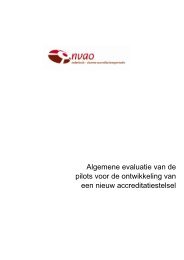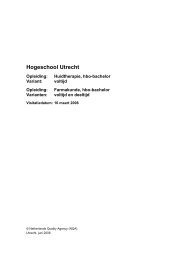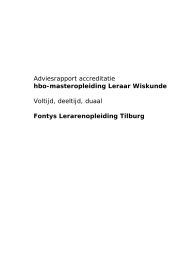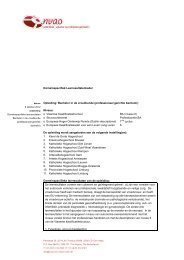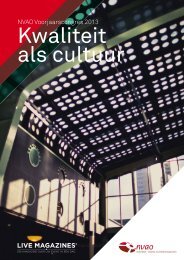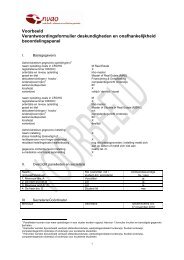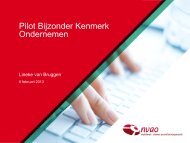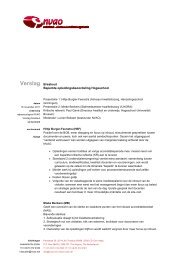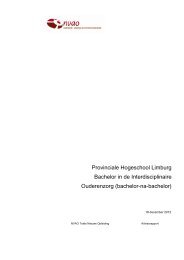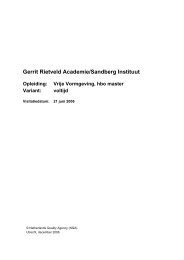Study on the Diploma Supplement as seen by its users - naric
Study on the Diploma Supplement as seen by its users - naric
Study on the Diploma Supplement as seen by its users - naric
You also want an ePaper? Increase the reach of your titles
YUMPU automatically turns print PDFs into web optimized ePapers that Google loves.
Good practices identified:<br />
- The ECTS is being used, when applicable.<br />
- Durati<strong>on</strong> is stated both in years and in workload (ECTS).<br />
3.3. Access requirement(s)<br />
Analysis and findings<br />
Chapter 3.3 helps in comparing <strong>the</strong> level of <strong>the</strong> qualificati<strong>on</strong> and should <strong>the</strong>refore refer<br />
foremost to <strong>the</strong> level of qualificati<strong>on</strong> that is required for admissi<strong>on</strong>. The chapter should again<br />
avoid using nati<strong>on</strong>al terminology <strong>on</strong>ly, and when possible, state <strong>the</strong> level of <strong>the</strong> educati<strong>on</strong><br />
required for access in terms of <strong>the</strong> NQF, EQF, or EHEA Framework. In additi<strong>on</strong>, admissi<strong>on</strong><br />
procedures, should be menti<strong>on</strong>ed when suitable, <strong>as</strong> <strong>the</strong>y give fur<strong>the</strong>r informati<strong>on</strong> <strong>on</strong> <strong>the</strong> level<br />
of <strong>the</strong> qualificati<strong>on</strong> and/or help compare and c<strong>on</strong>tr<strong>as</strong>t it with nati<strong>on</strong>al qualificati<strong>on</strong>s.<br />
Good practices identified:<br />
- The use of nati<strong>on</strong>al terminology al<strong>on</strong>e should be avoided and NQF/EQF/EHEA<br />
Framework used when available.<br />
- Admissi<strong>on</strong> procedures should be menti<strong>on</strong>ed when relevant.<br />
Chapter 4: Informati<strong>on</strong> <strong>on</strong> <strong>the</strong> c<strong>on</strong>tents and results gained<br />
This chapter, in particular 4.2 <strong>on</strong> programme requirements, provides <strong>the</strong> most valuable<br />
informati<strong>on</strong> for employers. For <strong>the</strong> purposes of professi<strong>on</strong>al recogniti<strong>on</strong> c<strong>on</strong>cerning such<br />
regulated professi<strong>on</strong>s where <strong>the</strong> informati<strong>on</strong> <strong>on</strong> <strong>the</strong> programme c<strong>on</strong>tent is essential in<br />
determining <strong>the</strong> eligibility for a given professi<strong>on</strong>, chapter 4.2 is also important.<br />
4.1. Mode of study<br />
Analysis and findings<br />
There were, in some examples studied, some difficulties in determining what <strong>the</strong> mode of<br />
study meant, or how <strong>the</strong> informati<strong>on</strong> should be given. This subchapter should inform <strong>the</strong><br />
reader <strong>as</strong> to whe<strong>the</strong>r <strong>the</strong> studies were taken <strong>on</strong> a full-time or a part-time b<strong>as</strong>is in compliance<br />
with <strong>the</strong> study programme. Typically <strong>the</strong> mode of study is full-time, but students may study,<br />
for example, <strong>on</strong> a part-time b<strong>as</strong>is or <strong>by</strong> distance learning, etc. However, if and when studying<br />
part-time is not <strong>the</strong> “official” state of affairs and does not alter <strong>the</strong> c<strong>on</strong>tent and programme<br />
requirements, it does not need to be menti<strong>on</strong>ed.<br />
Good practices identified:<br />
- When <strong>the</strong>re is an official mode of study determined in <strong>the</strong> study programme, it is<br />
stated here.<br />
4.2. Programme requirements<br />
Analysis and findings<br />
In this secti<strong>on</strong>, c<strong>on</strong>tent and formal requirements of <strong>the</strong> study programme, including final<br />
<strong>the</strong>sis, <strong>as</strong> well <strong>as</strong> objectives and aims of <strong>the</strong> educati<strong>on</strong> and learning outcomes should be<br />
stated. When describing learning outcomes <strong>the</strong> Higher Educati<strong>on</strong> Instituti<strong>on</strong> should take into<br />
account general, field-specific and programme-specific requirements. In some fields, or<br />
countries, <strong>the</strong>se are more formalised than in o<strong>the</strong>rs. This descripti<strong>on</strong> w<strong>as</strong> provided <strong>on</strong>ly <strong>on</strong> a<br />
few occ<strong>as</strong>i<strong>on</strong>s in <strong>the</strong> examples studied. The secti<strong>on</strong> f<strong>its</strong> well with <strong>the</strong> programme<br />
requirements and descripti<strong>on</strong>s menti<strong>on</strong>ed in most of <strong>the</strong> Quality Assurance Frameworks,<br />
which should c<strong>on</strong>tribute to <strong>the</strong> <strong>Diploma</strong> <strong>Supplement</strong>s. There were also various interpretati<strong>on</strong>s<br />
“<strong>Diploma</strong> supplement <strong>as</strong> <strong>seen</strong> <strong>by</strong> <strong>its</strong> <strong>users</strong>” 17




